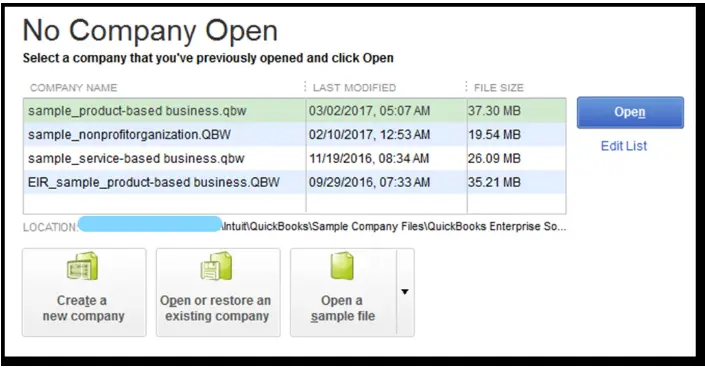How to Recover QuickBooks Data Files
Now the time has gone when you have to worry about data loss. As with the invention of Auto Data Recovery by Intuit, you can easily recover QuickBooks data files. It is one of the fastest and most effective ways to restore lost or corrupted data files.
Operating this feature, an automatic backup is created of your data file. Moreover, it also utilizes auto replication features that recreate a duplicate copy of .QBW and QuickBooks Transaction log files and auto data recovery. Go through this entire post to get in-depth information on how to recover QuickBooks data files using auto data recovery.
Have a one-to-one conversation with our professionals at +1-866-408-0444 to get information for all your queries within least time applicable.
What are the Different Types of QuickBooks Auto Data Recovery?
File recovery in the QuickBooks applications plays a major role in restoring the lost files of your business. This can be done in two different ways, which are as follows;
- Recover the lost transactions via the current QuickBooks Transaction log file (.TLG) and the last copy of the QuickBooks company file (.QBW).
- Recreating all the files but the last few hours of transactions, along with a copy of the company and transaction log files.
Related Post – How To Create and Send Purchase Orders in QuickBooks
Key Points You Must Know Before Using QuickBooks Auto Data Recovery Tool
Before proceeding further to use the auto data recovery tool in QuickBooks, you must consider the following considerations.
- The users can access the Auto Data Recovery file only available in the Pro, Premier, and Enterprise Solutions of Windows.
- You won’t be able to access the ADR file in Accountant Editions of QuickBooks.
- The ADR data recovery has a limited file size, mainly 1.5 Gigabytes. However, if the QuickBooks file is larger than 1.5 gigabytes, the ADR will not generate.
- Check that you are operating the most recently launched version to get the most out of this feature.
Read More:- QuickBooks Unrecoverable Error
Different Methods to Recover QuickBooks Data Files Using ADR Tool
You can run the QuickBooks Auto Data Recovery Tool on lost files by implementing the methods described below.
1. Make Use of the .TLG file with .QBW.adr file to Recover Recent Transactions
Here, we have described some simple steps to use .TLG file and .QBW.adr file to restore the lost files.
- Begin the process by establishing a new folder on the Desktop and label it as a QBTest folder.
- Navigate to the folder that contains your QuickBooks company file.
- Tip: You can get the location of your data file from the Product Information screen by hitting the F2 key. Then, opt for the No Company Open Window.

- Now, search for the .TLG file within your company file folder. .TLG file has the exact name as your company file. If the .TLG file isn’t visible to you, proceed further with the following steps:
- Initially, hit the Windows + E keys together to launch File Explorer on your screen.
- Move to Organise and then opt for the Folder and Search Options.
- Head towards the Hide extensions for known file types and click Apply, followed by OK.
- Next, copy the .TLG file and paste it into the newly generated folder i,e QBTEST.
- Access the QuickBooks Auto Data Recovery folder that you will find in the exact location where the data file is stored.
- After that, copy the .QBW.adr file and paste it into the QBTEST folder. You can now see both .QBW.adr and .TLG files on the newly constructed QBTEST folder.
- Navigate to your QBTEST folder, right-click the .QBW.adr file, and opt for Rename.
- Remove .adr at the end of the filename and then launch the data file saved on the QBTEST folder. Later, utilize your account register to see whether the transactions are present.
Learn More:- QuickBooks Database Server Manager
2. Operate .QBW.adr and .TLG.adr Files to Restore Recent Transactions
Go through the steps below to use .QBW.adr and .TLG.adr files to Restore a backup of your company file the lost transactions.
- To begin with, prepare a new folder on your Desktop and label it as QBTEST.
- Navigate to the location that carries your company file and then search for the QuickBooksAutoDataRecovery folder.
- Now, search for the .TLG.adr file and the .QBW.adr file. You will see that the name of this file is exactly as mentioned on the company file. If this file isn’t visible, implement these steps to show file extensions.
- Hit the Windows + E keys altogether to launch File Explorer on your screen.
- After this, go to Organise and then Folder and Search Options.
- Then, hover your cursor over the Hide Extensions for known file types.
- Later on, opt for the Apply option followed by OK.
- Afterwards, copy both file names i.e .TLG.adr and .QBW.adr and paste them to the QBTEST folder.
- Access the QBTEST folder, and wipe out .ADR at the end of the filename. In short, you will then see .QBW and .TLG files in your QBTEST folder.
- Launch the data file placed on your QBTEST folder and go through your account register to check that all the transactions are included.
Conclusion
In this post, we have provided you with all the details required to recover QuickBooks file from hard drive & recover QuickBooks data files using the ADR tool. However, if you still need any help, consult with our professionals at +1-866-408-0444 to get immediate results.
Frequently Asked Questions
What is the ADR tool in QuickBooks?
The ADR (Auto Data Recovery) tool is a built-in feature in QuickBooks Desktop that helps users recover lost or corrupted company data files by using backup copies created automatically by the software.
Can I recover all types of QuickBooks files using the ADR tool?
The ADR tool can recover essential company data files (.QBW and .TLG), but it does not restore attachments, templates, or payroll forms. It’s primarily used for restoring core accounting data.
How long does QuickBooks keep ADR backups?
QuickBooks stores ADR backups for up to 12 hours. It’s important to act quickly after data loss, as the tool only retains recent backup files.

Intuit has stopped providing new subscriptions for the QuickBooks Desktop 2024 and previous versions.
You can migrate to QuickBooks Online or switch to QuickBooks Desktop Enterprise.
Recent Posts
-
QuickBooks Payroll Calculator: Accurate Salary & Hourly Wages
-
Learn How to Create, Edit, or Delete Memorized Transactions in QuickBooks
-
How to Fix QuickBooks Time Login/sign in & Regain Access to the Account?
-
Revealing the Easy Methods to Fix QuickBooks Unexpected Error 5
-
QuickBooks Point of Sale Discontinued: Services Affected & More



